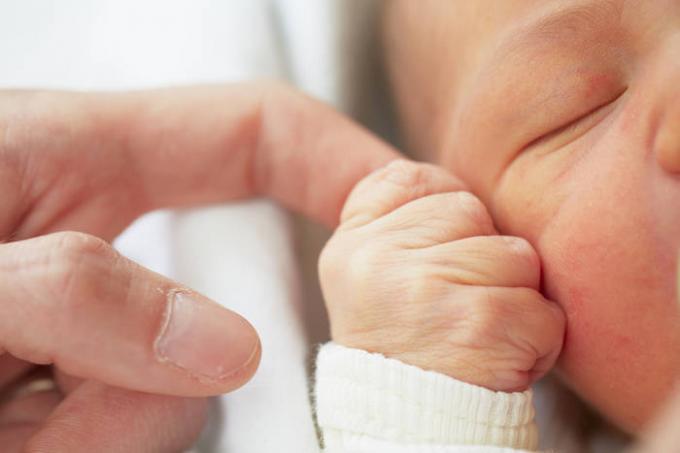umbilical remnant usually disappears within a week after birth. On the complete healing of the wound given to approximately 10-14 days. But in some cases, the wound continues to get wet and blush even after this date. What to do?
A reminder that the mother and child recently were one - umbilical the remainder, did not immediately heal. And in some cases, it gives parents a lot of trouble!
catarrhal omphalitis
Literally translated as the diagnosis of "inflammation of the navel." Signs of catarrhal omphalitis - poorly healing umbilical wound, from which stands out a small amount of pus. Sometimes it dries and forms scabs fall away. Temperature can jump to 38 degrees, but usually remains subfebrile: 37,2-37,5 degrees.
- Toddler becomes more sluggish, not sleeping and eating. Launched catarrhal omphalitis can move to the next - purulent - stage. Then the navel is red and inflamed, swells and thus rises above the belly. The child is added to the other symptoms of high fever. In severe cases, the umbilical wound covers dense scab, under which there is pus. If the disease has moved in this stage, the treatment may hold only a specialist.
- Recognize omphalitis easy. On analysis of the pus taken from the umbilical wound and blood. If it raised the level of white blood cells (the norm for their kids the first week of life - from 7.2 to 18.5 units, at the age of weeks to months - from 6.5 to 13.8 units) and erythrocyte sedimentation rate (greater than 4 mm / h), the diagnosis is likely to confirmed. At an early stage can be cured omphalitis home if 3-4 times a day to handle navel 3% hydrogen peroxide solution, and then - an antiseptic. Do not be afraid to burn the baby: the nerve endings in the umbilical cord and its residue is not.
Mushroom Body
Sometimes falling on the site of the umbilical cord is formed dense thickening, resembling a mushroom, hence the name it - Fungus. It is more common in newborns with high body weight (4 kg or more) and appears when proliferation of granulation tissue in the umbilical wound. Fungus on the health of the child are usually not affected, bleeding when it is usually not observed or is very weak.
Fungus Treated cauterization silver nitrate solution, together with conventional treatment umbilical wound. Surgical intervention is necessary only in severe cases.

Why not heal the navel: 5 Dangerous causes and how to help your child / istockphoto.com
When waiting for dangerous
In the first weeks of life of the embryo with umbilical cord connected embryonic duct 2, yolk and urinary,. The first of these is necessary for power as interconnects yolk sac and intestines, and the second urine output in the amniotic fluid. Regression of duct starts at about three months of intrauterine life: urinary atrophies and becomes a bundle on the inside of the abdominal wall, and the yolk disappears. But in the pathology of one of the ducts may persist - in whole or in part. Then the image of a full-time or part fistula.
8 times more often it happens to the yolk duct. At full fistula after falling of the umbilical cord of the baby gapes wide lumen of the intestine in place messages and navel. There are often released intestinal contents, while cleft of urinary flow - urine. Unfortunately, the only treatment that can be assigned here - an operation.
If the fistula is incomplete, it can be avoided. Symptoms in this case, less frightening: long weeping wound, sometimes with purulent secretions and often - with irritated skin. This condition is treated by daily baths with potassium permanganate, which is added before the water in a weak pink color, and treating the umbilical wound 3% hydrogen peroxide and then - 5% iodine solution or a 2% solution of brilliant green. But if for 6 months of the baby did not close an incomplete fistula, surgery still needed.
How to understand that the infection joined the umbilical wound
Omphalitis protracted and long bleeding from the umbilical wound can talk about the beginning of sepsis. This disease caused by bacteria that enter from the site of infection in the bloodstream, and from there - in other organs. Infected infection that lead to sepsis, a baby can cross the placenta, during the passage through the birth canal or after the birth, if the situation in the hospital is not enough sterile.
The organism bacteria penetrate not only through the umbilical wound, but also through the skin and mucous membranes. At the site of the entrance gate of infection produced inflammation. Early sepsis is considered that began before the 4th day of life, late - if the baby is ill on day 5 and later.
- In the first case, the reason usually become enterococci, E. coli, cytomegalovirus or Candida albicans causing candidiasis.
- Late sepsis often caused Haemophilus influenzae, Staphylococcus aureus and Pseudomonas aeruginosa - one of the main pathogens of nosocomial infections.
- The first signs of sepsis are general in nature: fatigue, poor sleep and appetite. But unstable or elevated body temperature, slow heart rate, pale skin, vomiting and cyanosis nasolabial triangle should leave no doubt: immediately call a doctor! In sepsis requiring hospitalization.
Sepsis: a group of risk
- Weight: less than 2 kg (premature infants)
- Gender: Male
- Other factors: multiple pregnancy, early discharge of water, maternal infection, artificial feeding.
Proper care of the umbilical wound
- treat the umbilical wound every day after bathing
- Use chlorhexidine, povidone-iodine, brilliant green solution or 1% solution hlorfillipta
- if a crust wound ready to fall off, remove it before these moistening hydrogen peroxide (3%)
Also you will be interested to read this: how to handle navel newborn

